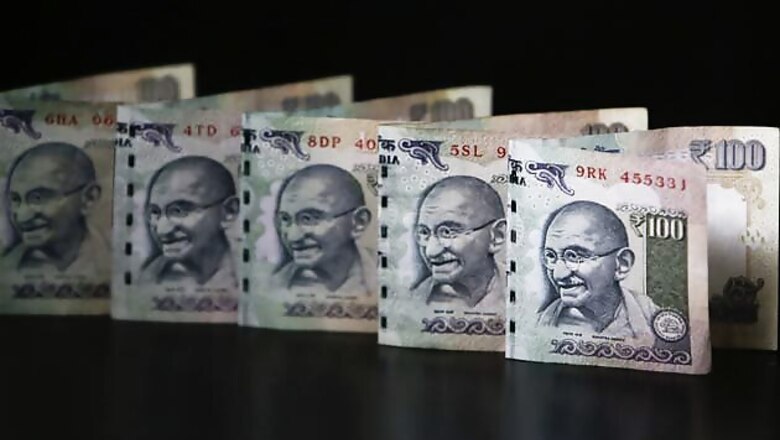
views
Mumbai: The rupee fell to a record low on Friday as measures to curb foreign currency outflows were seen as the latest roll of the dice by policymakers struggling to defend the currency in a slowing economy and a toughening global investment environment.
Far from propping up the currency, the measures from the Reserve Bank of India late on Wednesday to restrict how much its citizens and companies can invest abroad raised fears of outright capital controls that would further undermine the confidence of foreign investors.
Policymakers have cobbled together a slew of steps over the past month in a bid to halt the rupee's slide, including the RBI's extraordinary steps on July 15 to drain cash from the system and raise short-term interest rates in an economy already growing at a decade low.
Yet none of the steps unveiled so far have convinced investors that India can attract overseas investments, which is seen as essential in narrowing a record high current account deficit that is the biggest source of the rupee weakness.
The approach is beginning to test the patience of foreign investors, just when emerging markets such as India are already seen as particularly vulnerable ahead of the expected tapering of monetary stimulus by the U.S. Federal Reserve.
"They're coming across as a bit panicky. That's what is damaging sentiment for investors," said Jonathan Schiessl, a fund manager at Ashburton Investments in Jersey, referring to the RBI's actions to defend the rupee.
"Unless things improve, we will probably in all likelihood be withdrawing some weightings from our India positions."
The partially convertible rupee fell to an all-time low of 62.03 to the dollar as trading began. By 2:30 p.m., it was trading at 61.88, weaker than its Wednesday's close of 61.43/44. Markets were closed on Thursday for a holiday.
The RBI's capital outflow restrictions came a day before the dollar spiked after U.S. jobless claims data on Thursday suggested an early end to the Fed's asset purchases.
That prospect looms over India at a time when it is suffering from a current account deficit that hit a record high of 4.8 per cent of gross domestic product and an economy growing at a decade low of 5 percent.
Foreign investors have already sold a net $11.6 billion of Indian debt and equities since late May, sparking fears of continued weakness.
The Nifty fell 4 percent at one point on Friday, while benchmark 10-year bond yields surged to their highest since May 2012 as prices headed for their worst week in four-and-a-half years.
UBS strategist Manik Narain said that as emerging central banks tightened policy to defend their currencies, stocks would be affected, something that is already happening in India.
"India is losing control over the currency and you are starting to see the weakness transmitting to stock markets. There could be a self-perpetuating cycle where currency weakness flushes out equity investors and that takes the rupee weaker still."
The RBI's new measures also included further capping the amount that companies can invest abroad.
But overseas investments from India had already been on the wane, averaging a monthly $400 million in the first half of the year from $710 million in 2012, according to DBS data.
The biggest fear is that the RBI's action could be the start of a far stronger move to restrain capital.
"The steps taken so far only target residents, but if this raises expectations that they could potentially resort to capital controls targeted at non-residents, that could have adverse near-term implications for capital flows," HSBC's Chief economist for India and ASEAN Leif Eskesen said.
"It will, therefore, be critical to tread very carefully when it comes to capital controls, to anchor expectations, and also not use it as a substitute for more appropriate and effective measures," Eskesen said in a note to clients.
As policy makers struggling to find a solution for the rupee's falls, investors expect more weakness ahead. Overseas investors betting via one-month offshore non-deliverable forwards quoted the rupee trading at 62.46, while onshore bets see the rupee at 62.35 within the month.
Meanwhile, a Reuters poll on Thursday showed short positions in the Indian rupee have hit the highest in two months.
At heart of India's failed defence of the rupee so far is that none of the measures unveiled so far have given markets assurance that the country can attract foreign flows in an increasingly difficult global environment.
India last month unveiled plans to further ease restrictions on foreign direct investment (FDI) but previous measures have had mixed results. FDI fell to $36.9 billion in the fiscal year ending in March from $46.6 billion the previous year.
This week it announced measures to attract near-term capital inflows, including by spurring state-run companies to sell debt abroad and raising funds from Indians abroad.
Yet doing so could prove hard without major confidence-inspiring reforms, especially as RBI measures last month to drain cash raise the prospect that borrowing costs will rise.
"We remain underweight on Indian credits as the current spreads do not offer enough compensation in our view," said Arthur Lau, head of fixed income for Asia ex-Japan for Pinebridge Investments in Hong Kong.
















Comments
0 comment